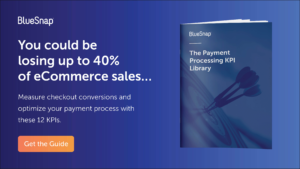Last week on our blog, we published an article covering the basics of a payment gateway, including how it works and what it can do for your business. But that’s not the whole story when it comes to how payment systems work—there’s still that little matter of how you, the eCommerce merchant, receive the incoming transaction funds. Merchant accounts go hand-in-hand with payment gateways and are an integral part of the payment process.
So what is a merchant account? Read on to find out.
What is a merchant account?
A merchant account is an account that enables merchants to process customer credit and debit payments. Since merchandise can be returned, there’s always the chance that some of the money you receive as a merchant will have to be paid back—which accounts for a certain level of risk involved.
You don’t cut checks from these accounts; the funds are transferred into your business’s bank account by your gateway. And those returns we mentioned? They’ll be subtracted from whatever sits in the merchant account at that time.
How does a merchant account work?
If you read our blog post on payment gateways, you might recall that it’s the job of the acquiring bank to get authorization for customer transactions from issuing banks like Wells Fargo, Bank of America, etc.
At the end of the day, your merchant processor tallies up the approved transaction amounts from each issuing bank and requests that the funds be paid. Those funds are then distributed into your merchant account. This process typically takes anywhere from 2-4 days, though there is some variance by card type and region. You should reconcile your merchant account on a daily basis to ensure that the funds flowing in and out match up with the sales and returns recorded in your payment gateway.
How do I get a merchant account?
Many payment gateway providers, like BlueSnap, are full-service payment solution providers, which means they provide eCommerce merchant accounts to their customers along with a payment gateway and processing solution. (That’s not always the case, though, so be sure to find out before signing on with a provider!)
If you’re in the market for a payment gateway provider, don’t sign on the dotted line until you’ve asked these 10 questions!
Because the provider of the merchant account (not necessarily the gateway provider) is doing the underwriting, banks who agree to partner with payment gateway providers are, in essence, trusting them to do their due diligence. Setting up merchant accounts is a fairly complex process, because every merchant has a slightly different risk profile (think Macy’s vs. Joe’s T-Shirt Shop). It’s important for providers to follow a consistent underwriting process to ensure that the payment system works as its intended.
What makes some merchant accounts different than others?
1. Some make global commerce easier.
Some merchant accounts can only receive money in USD, whereas an internationally-minded gateway provider can set one up to accept multiple currencies. So if you’re looking to grow globally, it’s a good idea to not only let your customers pay using their local currency (that’s a job for the payment gateway!) but also to set up a multi-currency eCommerce merchant account.
2. Some have a more sophisticated underwriting process.
Some gateway providers dig deeper in the underwriting process, taking into account the complexities and characteristics of each individual merchant and really understanding your business. A customized underwriting process leads to fewer problems down the road, making it more likely that your business will be able to easily handle the daily ebb and flow of funds within the account. It also helps avoid an unexpected shutdown of the account due to miscalculations—a more common occurrence when merchants are all assigned equal levels of risk. These situations happen most often with providers who promise “instant underwriting.” There is no magic wand; so this idea of “instant” should be a red flag.
3. Some are shared, or aggregate, accounts.
Some eCommerce merchant accounts are shared among all the merchants serviced by the payment gateway provider. That means your risk profile is blended in with all the other merchants in the pool—which may be an advantage for some merchants but not for others. Before you sign on with any gateway provider, ask if you’ll have a dedicated or aggregate account and consider the implications for your business.
Streamline Your Payment Process With The Right Merchant Account
Take a look at our website to find out more about BlueSnap’s merchant account features and how they can benefit your business. Or simply give us a call. Our Conversion Consultants can give you advice about ways to optimize your payment system and help design your payment infrastructure so it fits your business needs.
Related Resources:


